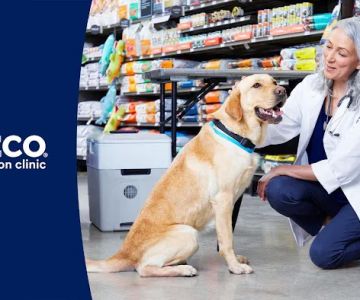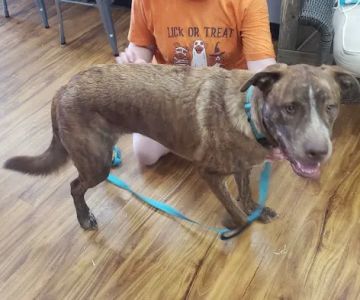Top Tips for Keeping Your Dog Calm at the Vet
Taking your dog to the vet can be a stressful experience—for both you and your dog. Whether it’s for a routine check-up, vaccinations, or a more involved treatment, it’s common for dogs to feel anxious in a clinical setting. However, there are several ways you can help your dog stay calm and relaxed during their vet visits. In this article, we’ll explore some effective tips for keeping your dog calm at the vet and how you can ensure a positive experience for both of you.
1. Why Are Dogs Nervous at the Vet?
Before we dive into the solutions, it’s important to understand why dogs may feel anxious at the vet. There are several factors that can contribute to a dog’s nervousness:
- Unfamiliar Environment: Vets are usually a place your dog doesn’t visit regularly, and the unfamiliar smells, sounds, and people can cause anxiety.
- Separation Anxiety: Dogs are social creatures, and being separated from their owner during the visit can heighten feelings of insecurity.
- Past Negative Experiences: If a dog has had a previous traumatic experience at the vet, such as receiving a shot or undergoing a procedure, they might associate the vet with fear.
By understanding the reasons behind your dog's anxiety, you’ll be better equipped to help them stay calm during their visit.
2. Prepare Your Dog Before the Visit
One of the best ways to ensure your dog stays calm at the vet is to prepare them ahead of time. This can be especially useful if your dog is anxious about going to the vet.
- Get Your Dog Used to the Car: Many dogs get nervous in the car, which can be amplified when they’re heading to the vet. Start by taking your dog on short car rides that have positive associations, such as to the park or for a treat, so they associate the car with good experiences.
- Practice Handling: Vets will need to examine your dog, so it's important they are comfortable with being touched. Practice handling their paws, ears, and mouth at home to desensitize them to being touched.
- Take Your Dog to the Vet Before the Appointment: Some veterinarians allow you to bring your dog in for a visit without an appointment just to get used to the surroundings. This is a great way to help your dog feel more comfortable in the vet’s office before the actual appointment.
3. Use Calming Aids
Sometimes, no matter how much we prepare, dogs may still struggle with anxiety at the vet. Luckily, there are several calming aids available that can help manage your dog’s stress levels:
- Calming Treats: There are several calming treats on the market that contain ingredients like valerian root or L-theanine, which have natural sedative effects. Giving your dog a calming treat 30 minutes before the visit can help them feel more relaxed.
- Adaptil Diffusers or Sprays: Adaptil is a synthetic version of the calming pheromone that dogs naturally produce. These products can be sprayed on your dog's collar or used in the car to help calm them down during the trip to the vet.
- Thundershirts: A Thundershirt is a garment that applies gentle pressure to your dog’s body, providing a calming effect. Many dogs respond well to this pressure, which helps to reduce anxiety.
4. Consider Taking Your Dog to a Low-Stress Vet
Not all veterinary clinics are created equal, and some are better equipped to deal with nervous dogs. If your dog struggles with vet visits, consider finding a low-stress veterinary practice that specializes in fear-free handling techniques. These clinics focus on minimizing stress during the exam and may offer a calmer, more relaxing environment for your pet.
- Fear-Free Certified Vets: Look for veterinarians who are certified in Fear-Free practices. These professionals are trained to handle pets with anxiety and use techniques to minimize stress during the visit.
- Low-Volume Clinics: Smaller, less crowded veterinary offices may offer a quieter, more relaxed experience for your dog compared to busy, high-traffic practices.
5. Be Calm and Encouraging
Your dog looks to you for reassurance, so your behavior during the visit can have a significant impact on their anxiety level. It’s important to stay calm and confident, as your dog will pick up on your emotions. Here are a few ways you can help your dog feel more at ease:
- Stay Calm: If you’re anxious, your dog will likely pick up on those feelings. Try to stay relaxed, speak in a calm voice, and avoid showing signs of stress.
- Offer Positive Reinforcement: Reward your dog with treats and praise for calm behavior at the vet. This reinforces that good things happen when they stay calm.
- Avoid Overly Long Visits: Long appointments can cause your dog to become agitated. If possible, schedule shorter appointments to reduce the time your dog spends in the stressful environment.
6. Seek Help If Needed
If your dog’s anxiety is severe or they have a history of trauma at the vet, don’t hesitate to seek professional help. A professional dog trainer or behaviorist can work with you and your dog to develop a tailored training plan to reduce anxiety. In some cases, your vet might also recommend anti-anxiety medication to help your dog cope during visits.
At Hidden Brook Veterinary, we understand how important it is for both pets and owners to have a stress-free experience. If you’re looking for advice, training resources, or veterinary services, we’re here to help you and your dog.
SEO Title: How to Keep Your Dog Calm at the Vet SEO Keywords: dog calm at vet, calming tips for dog at vet, reduce dog anxiety at vet, dog behavior, veterinary stress management SEO Description: Learn top tips for keeping your dog calm at the vet, including preparation strategies, calming aids, and low-stress vet clinics. Make your pet’s visit a positive experience.










